Effect of Curing Temperature on the Properties of Electrically Controlled Dimming Film with Wide Working Temperature Range
Abstract
:1. Introduction
2. Experimental
2.1. Materials
2.2. Sample Preparation
2.3. Characterizations
3. Results and Discussion
3.1. Analysis of Phase Transition Point of the Mixtures of LC/Prepolymer
3.2. Micromorphology of PDLC Films at Various Curing Temperatures
3.3. The E-O Properties of PDLC Films at Various Curing Temperatures
3.4. Analysis of Working Temperature of PDLC Film
4. Conclusions
Author Contributions
Funding
Conflicts of Interest
References
- Kajiyama, T. Characterization and gas permeation of polycarbonateliquid crystal composite membrane. J. Membr. Sci. 1982, 11, 39–52. [Google Scholar] [CrossRef]
- Kajiyama, T.; Washizu, S.; Takayanagi, M. Membrane structure and permeation properties of poly(vinyl chloride)/liquid crystal composite membrane. J. Appl. Polym. Sci. 1984, 29, 3955–3964. [Google Scholar] [CrossRef]
- Nasir, N.; Kumar, S.; Kim, M.; Nguyen, V.H.; Suleman, M.; Park, H.M.; Lee, S.; Kang, D.; Seo, Y. Effect of the Photoinitiator Concentration on the Electro-optical Properties of Thiol-Acrylate-Based PDLC Smart Windows. ACS Appl. Energy Mater. 2022, 5, 6986–6995. [Google Scholar] [CrossRef]
- David, C. Polymer-dispersed liquid crystals. J. Mater. Chem. 1995, 5, 2063–2072. [Google Scholar] [CrossRef]
- Chen, G.; Hu, W.; Zhou, L.; Zhang, H.; Wang, L.; Zhang, C.; Sun, J.; Zhang, L.; Yuan, X.; Zhu, S. The electro-optical properties and adhesion strength of epoxy-polymercaptan-based polymer dispersed liquid crystal films. Crystals 2021, 11, 576. [Google Scholar] [CrossRef]
- Li, W.; Cheng, Z.; Pan, G.; Liu, H.; Cao, H.; Yang, Z.; Yang, H. Effects of the mixture composition on the microstructure of polymer matrix and light scattering properties of liquid crystal/photo-polymerizable monomers composites. Opt. Mater. 2008, 31, 434–439. [Google Scholar] [CrossRef]
- Saeed, M.; Zhang, S.; Cao, Y.; Zhou, L.; Hu, J.; Muhammad, I.; Xiao, J.; Zhang, L.; Yang, H. Recent advances in the polymer dispersed liquid crystal composite and its applications. Molecules 2020, 25, 5510. [Google Scholar] [CrossRef]
- Meng, X.; Li, J.; Lin, Y.; Liu, X.; Zhao, J.; Li, D.; He, Z. Periodic Electro-Optical Characteristics of PDLC Film Driven by a Low-Frequency Square Wave Voltage. Crystals 2022, 12, 163. [Google Scholar] [CrossRef]
- Hakemi, H. The effect of thickness on electro-optical properties of plastic UV-curable polymer dispersed liquid crystal (PDLC). Mol. Cryst. Liq. Cryst. 2019, 689, 34–43. [Google Scholar] [CrossRef]
- Elouali, F.Z.; Yaroshchuk, O.; Maschke, U. A wide-range controlling of optical and morphological parameters of PDLC samples via the intensity of curing light. Mol. Cryst. Liq. Cryst. 2010, 526, 1–9. [Google Scholar] [CrossRef]
- Li, W.; Cao, H.; Kashima, M.; Liu, F.; Cheng, Z.; Yang, Z.; Zhu, S.; Yang, H. Control of the microstructure of polymer network and effects of the microstructures on light scattering properties of UV-cured polymer-dispersed liquid crystal films. J. Polym. Sci. B Polym. Phys. 2008, 46, 2090–2099. [Google Scholar] [CrossRef]
- Hakemi, H. The effect of curing temperature and time on morphology and electro-optical properties of flexible thermoset polymer dispersed liquid crystal (PDLC) films. Mol. Cryst. Liq. Cryst. 2020, 703, 1–12. [Google Scholar] [CrossRef]
- Vaz, N.A.; Montgomery, G.P. Refractive indices of polymer-dispersed liquid-crystal film materials: Epoxy-based systems. J. Appl. Phys. 1987, 62, 3161–3172. [Google Scholar] [CrossRef]
- Montgomery, G.P.; Vaz, N.A. Light-scattering analysis of the temperature-dependent transmittance of a polymer-dispersed liquid-crystal film in its isotropic phase. Phys. Rev. A 1989, 40, 6580–6591. [Google Scholar] [CrossRef] [PubMed]
- Miao, Z.; Wang, D.; Zhang, Y.; Song, P.; Wang, J.; Wu, X. Effects of mesogenic compound with high birefringence on electro-optical properties of heat-cured polymer-dispersed liquid crystal films. Mol. Cryst. Liq. Cryst. 2013, 582, 72–78. [Google Scholar] [CrossRef]
- Wu, S.; Wu, C. Experimental confirmation of the Osipov-Terentjev theory on the viscosity of nematic liquid crystals. Phys. Rev. A 1990, 42, 2219. [Google Scholar] [CrossRef]
- Ahmad, F.; Jamil, M.; Jeon, Y.J.; Woo, L.J.; Jung, J.E.; Jang, J.E.; Lee, G.H.; Park, J. Comparative study on the electrooptical properties of polymer-dispersed liquid crystal films with different mixtures of monomers and liquid crystals. J. Appl. Polym. Sci. 2011, 121, 1424–1430. [Google Scholar] [CrossRef]
- Zhang, H.; Cao, H.; Chen, M.; Zhang, L.; Jiang, T.; Chen, H.; Li, F.; Zhu, S.; Yang, H. Effects of the fluorinated liquid crystal molecules on the electro-optical properties of polymer dispersed liquid crystal films. Liq. Cryst. 2017, 44, 2301–2310. [Google Scholar] [CrossRef]
- Park, N.; Cho, S.; Kim, J.; Suh, K. Preparation of polymer-dispersed liquid crystal films containing a small amount of liquid crystalline polymer and their properties. J. Appl. Polym. Sci. 2000, 77, 3178–3188. [Google Scholar] [CrossRef]
- Cussler, E.L. Diffusion: Mass Transfer in Fluid Systems; Cambrige Universtiy Press: Cambrige, UK, 2000. [Google Scholar]
- Montgomery, G.P.; West, J.L.; Tamurammis, W. Light scattering from polymer-dispersed liquid crystal films: Droplet size effects. J. Appl. Phys. 1991, 69, 1605–1612. [Google Scholar] [CrossRef]
- Xu, J.; Yu, M.; Chen, G.; Wang, X.; Hu, J.; Zou, C.; Wang, Q.; Xiao, J.; Gao, Y.; Zhu, S.; et al. Study on the preparation and performance of an electrically controlled dimming film with wide working temperature range. J. Mol. Liq. 2022, 367, 120408. [Google Scholar] [CrossRef]
- Deshmukh, R.R.; Katariya Jain, A. The complete morphological, electro-optical and dielectric study of dichroic dye-doped polymer-dispersed liquid crystal. Liq. Cryst. 2014, 41, 960–975. [Google Scholar] [CrossRef]
- Saeed, M.H.; Zhang, S.; Yu, M.; Zhou, L.; Yang, H. Effects of oxygen heterocyclic acrylate monomers on the morphologies and electro-optical properties of polymer dispersed liquid crystal composite films. Optik 2021, 229, 166254. [Google Scholar] [CrossRef]
- Drzaic, P.S. Some Factors Influencing Light Scattering in PDLC Films; SPIE: New York, NY, USA, 1993; Volume 1911, pp. 153–159. [Google Scholar] [CrossRef]
- Liu, F.; Cao, H.; Mao, Q.; Song, P.; Yang, H. Effects of monomer structure on the morphology of polymer networks and the electro-optical properties of polymer-dispersed liquid crystal films. Liq. Cryst. 2012, 39, 419–424. [Google Scholar] [CrossRef]
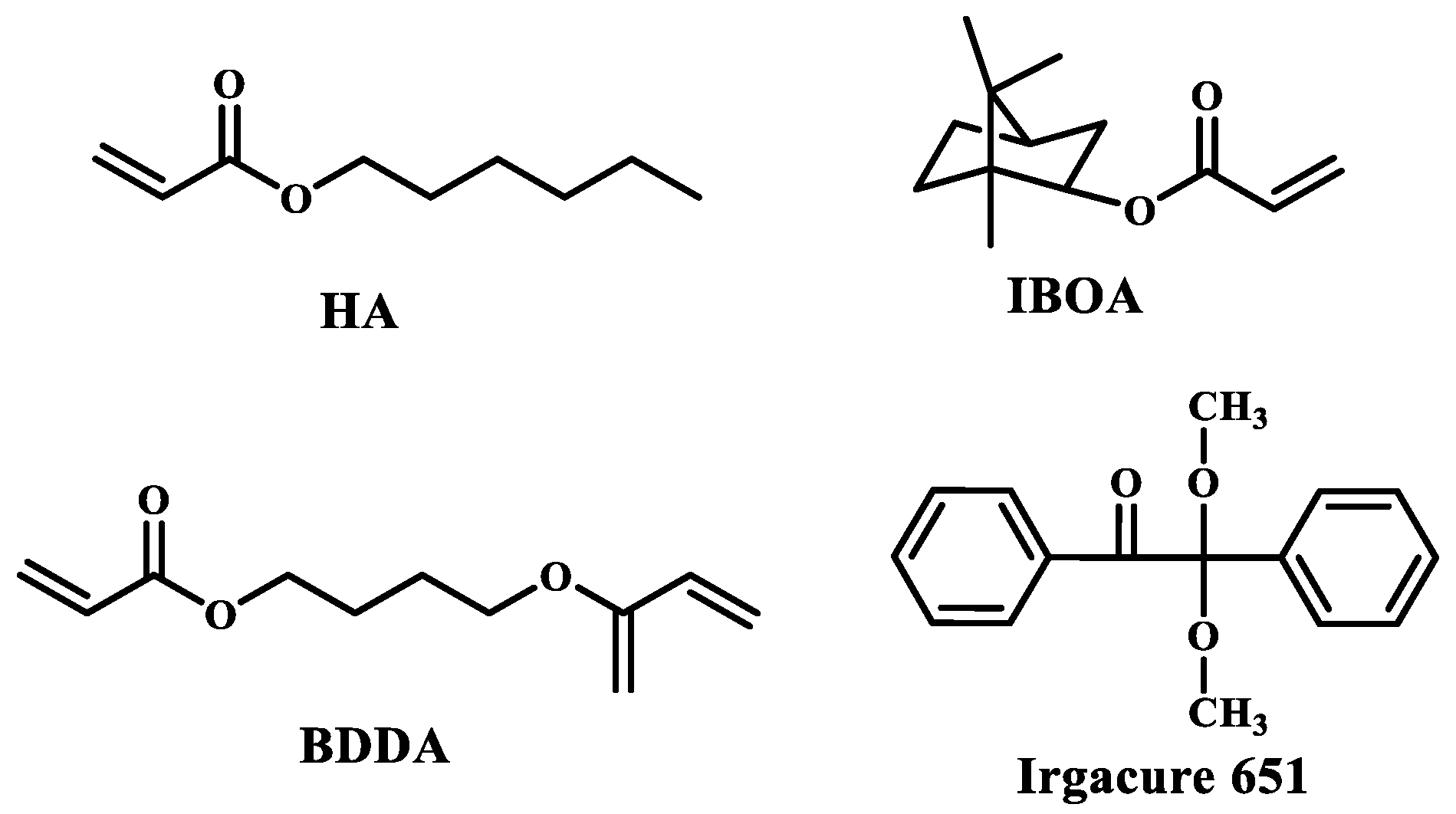
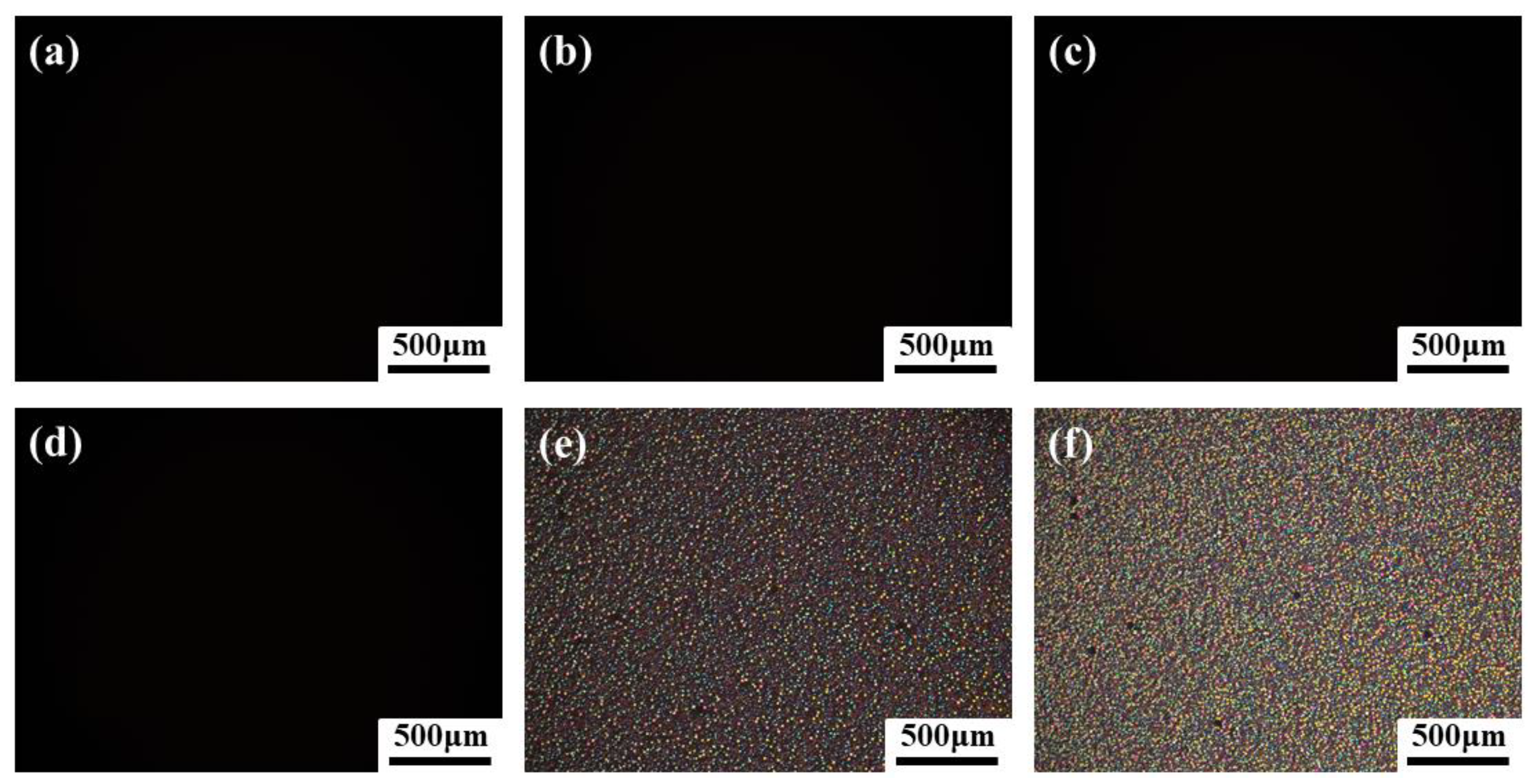
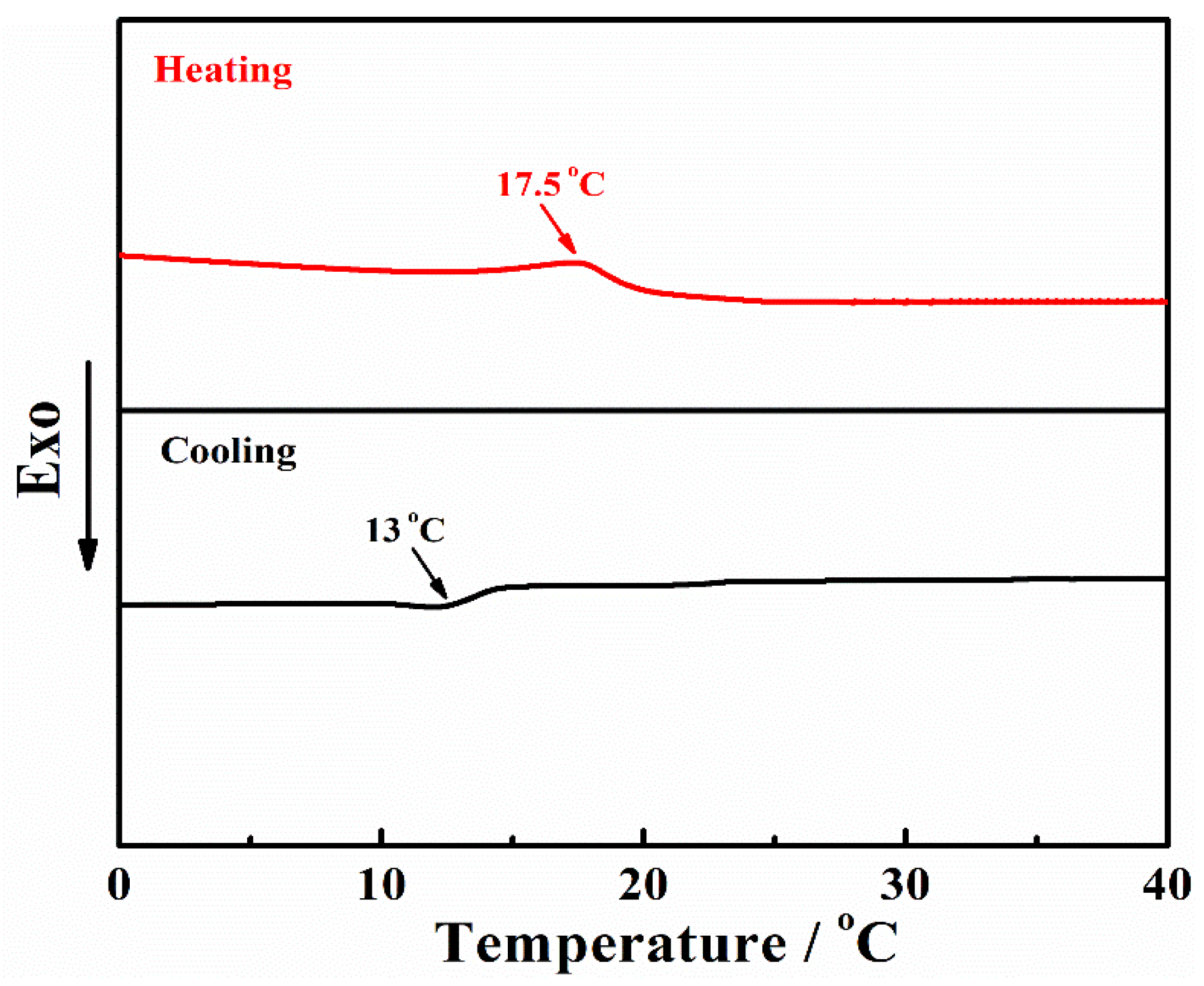
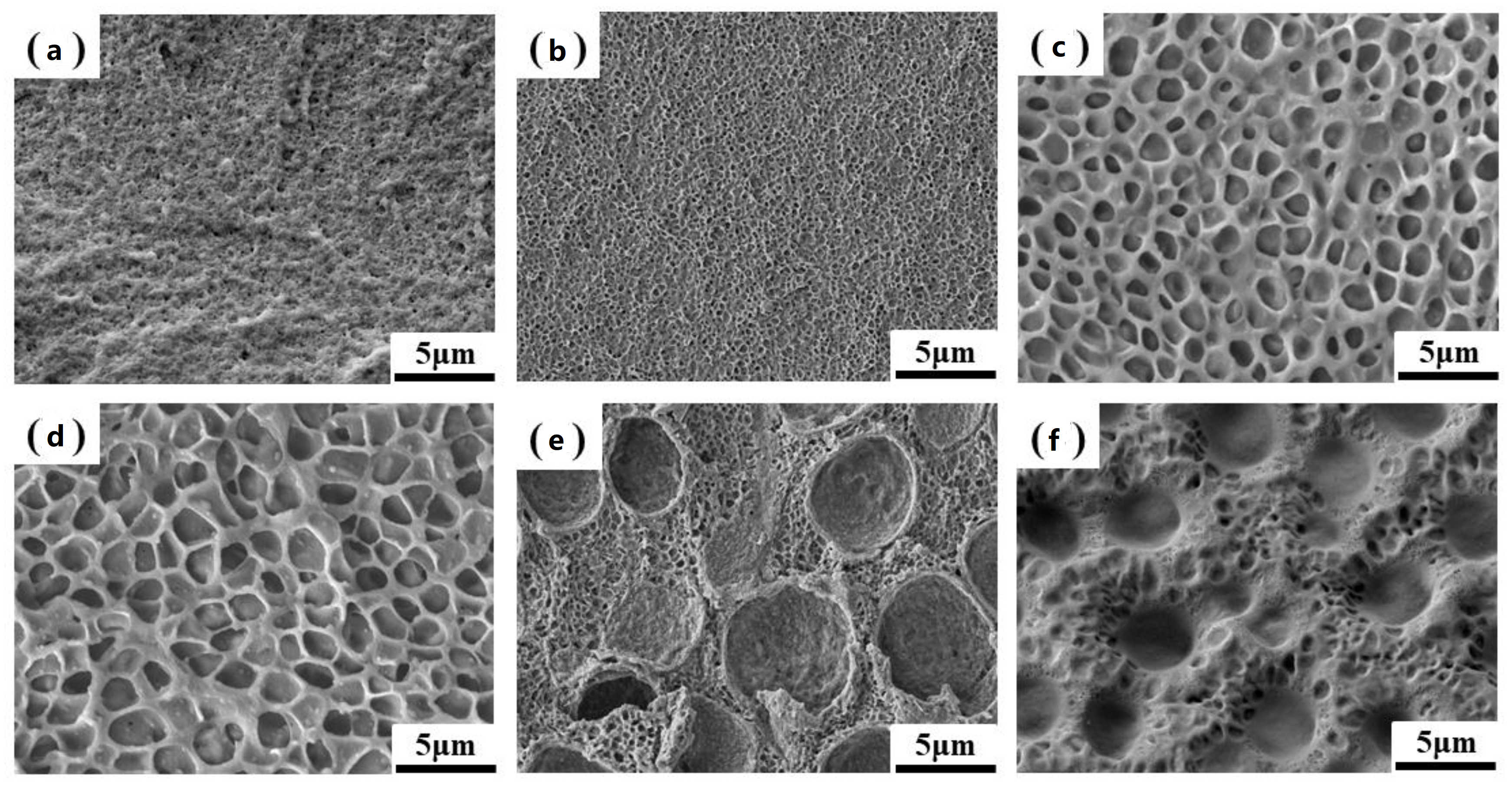
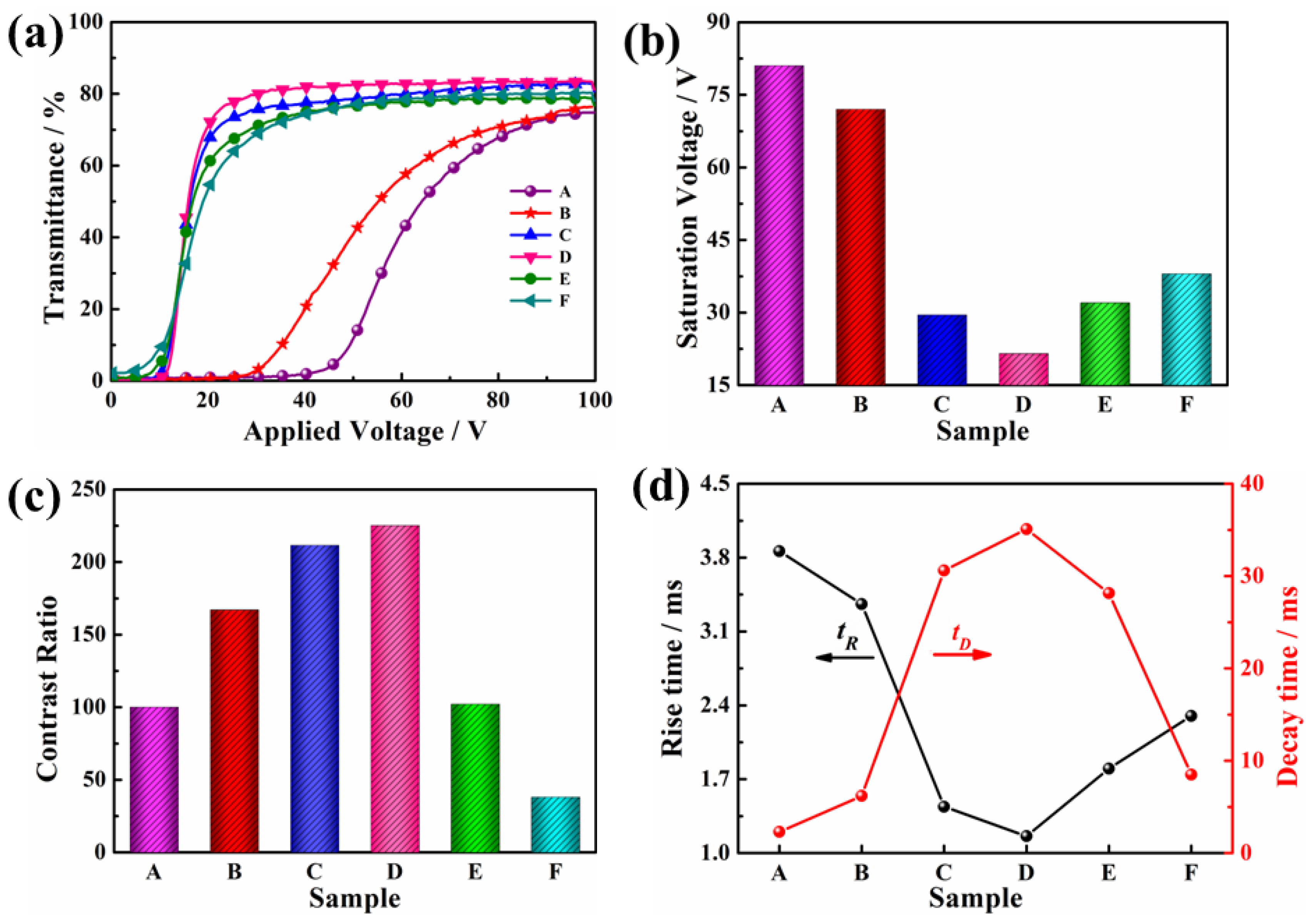
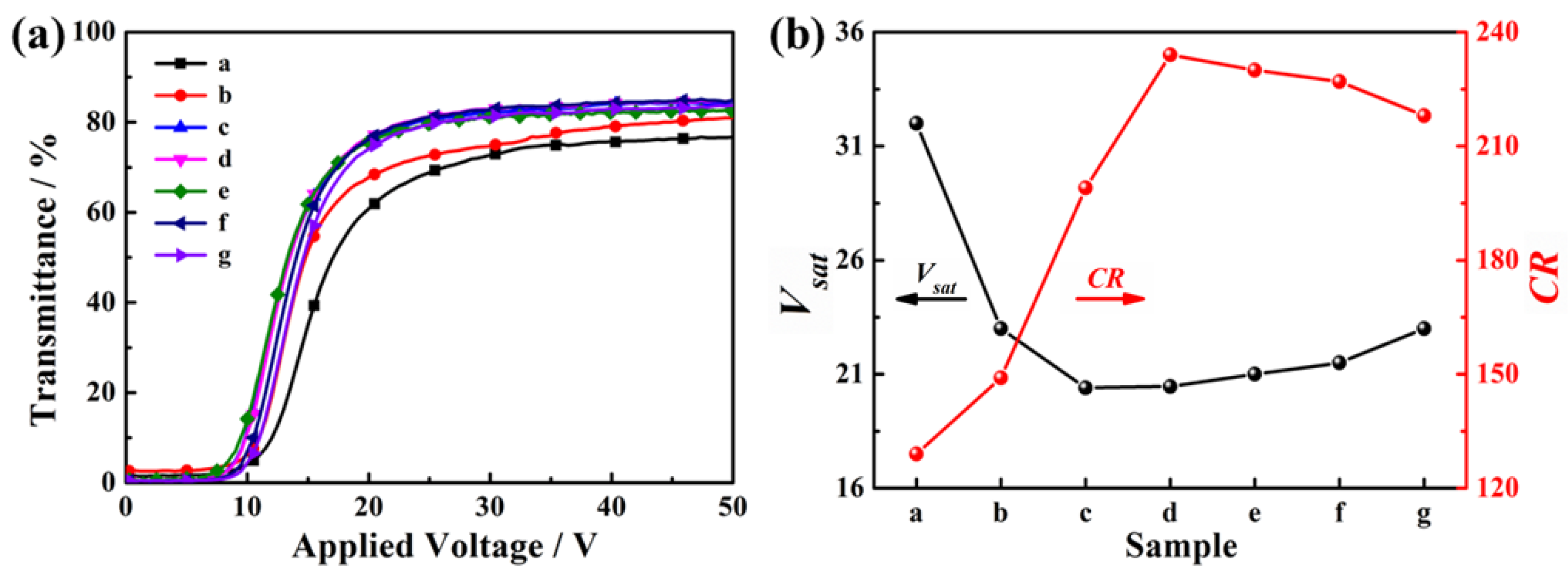


| Formula | Polymerization Conditions | |||
|---|---|---|---|---|
| Sample | Composition | Weight Ratio (wt. %) | Curing Temperature (°C) | Curing Light Intensity (mW/cm2) |
| A | HA/IBOA/BDDA/LC | 18/6/6/70 | 50 | 14 |
| B | HA/IBOA/BDDA/LC | 18/6/6/70 | 40 | 14 |
| C | HA/IBOA/BDDA/LC | 18/6/6/70 | 30 | 14 |
| D | HA/IBOA/BDDA/LC | 18/6/6/70 | 20 | 14 |
| E | HA/IBOA/BDDA/LC | 18/6/6/70 | 10 | 14 |
| F | HA/IBOA/HDDA/LC | 18/6/6/70 | 0 | 14 |
| a | HA/IBOA/BDDA/LC | 18/6/6/70 | 12 | 14 |
| b | HA/IBOA/BDDA/LC | 18/6/6/70 | 14 | 14 |
| c | HA/IBOA/BDDA/LC | 18/6/6/70 | 16 | 14 |
| d | HA/IBOA/BDDA/LC | 18/6/6/70 | 18 | 14 |
| e | HA/IBOA/BDDA/LC | 18/6/6/70 | 20 | 14 |
| f | HA/IBOA/HDDA/LC | 18/6/6/70 | 22 | 14 |
| g | HA/IBOA/HDDA/LC | 18/6/6/70 | 24 | 14 |
Publisher’s Note: MDPI stays neutral with regard to jurisdictional claims in published maps and institutional affiliations. |
© 2022 by the authors. Licensee MDPI, Basel, Switzerland. This article is an open access article distributed under the terms and conditions of the Creative Commons Attribution (CC BY) license (https://creativecommons.org/licenses/by/4.0/).
Share and Cite
Xu, J.; Li, H.; Guo, L.; Zhang, Z.; Zou, C.; Wang, Q.; Yang, H.; Wang, X.; Yu, M.; Gao, Y. Effect of Curing Temperature on the Properties of Electrically Controlled Dimming Film with Wide Working Temperature Range. Crystals 2022, 12, 1551. https://doi.org/10.3390/cryst12111551
Xu J, Li H, Guo L, Zhang Z, Zou C, Wang Q, Yang H, Wang X, Yu M, Gao Y. Effect of Curing Temperature on the Properties of Electrically Controlled Dimming Film with Wide Working Temperature Range. Crystals. 2022; 12(11):1551. https://doi.org/10.3390/cryst12111551
Chicago/Turabian StyleXu, Jianjun, Hui Li, Lei Guo, Zuowei Zhang, Cheng Zou, Qian Wang, Huai Yang, Xiao Wang, Meina Yu, and Yanzi Gao. 2022. "Effect of Curing Temperature on the Properties of Electrically Controlled Dimming Film with Wide Working Temperature Range" Crystals 12, no. 11: 1551. https://doi.org/10.3390/cryst12111551
APA StyleXu, J., Li, H., Guo, L., Zhang, Z., Zou, C., Wang, Q., Yang, H., Wang, X., Yu, M., & Gao, Y. (2022). Effect of Curing Temperature on the Properties of Electrically Controlled Dimming Film with Wide Working Temperature Range. Crystals, 12(11), 1551. https://doi.org/10.3390/cryst12111551









